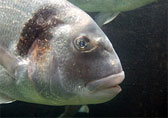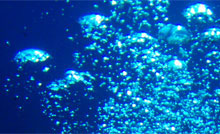Ocean Acidification Series
Ocean Acidification: The Unknown Reality of Climate Change
Plankton Life Already Weakened by CO2
The Luck of the Fish: for How Long?
Finding a Cure Despite Uncertainties
The Hopes of Ecosystem Modelling |
The Luck of The Fish: for How Long? |
 Big wave in southern ocean- credit: Margrith Ettlin, Alfred Wegener Institute Big wave in southern ocean- credit: Margrith Ettlin, Alfred Wegener Institute
|
By Laurene Mainguy, May 2009 |
|
It is unclear how the marine ecosystem as a whole will react to CO2, but it is quite certain that fish are among the fittest for survival. |
Atsushi Ishimatsu is a fish scientist at Nagasaki University. In a recent study, he found that when exposed to CO2 concentrations 130 times as high as todays levels, fish can die from a heart attack. But such CO2 pressures are extremely high and unlikely to happen.
Ishimatsu said fish will mainly suffer from CO2 through food web changes, for they feed on plankton organisms which are sensitive to CO2. The structure of the fish community might change and some populations might shrink, he said ''But at this moment it is very difficult, probably impossible to answer this question.''
Food web changes could seriously impact marine mammals as well. Penguins might have a harder time feeding on marine snails, because those pteropods may not be able to calcify anymore, said marine science specialist Gretchen Hoffman to UPI. Besides, Ishimatsu and other scientists in Tasmania suspect that krills, a main food source for whales and seals in the southern ocean, are threatened by CO2.
Fish are less sensitive to CO2 than marine invertebrates because they are better equipped to cope with an acidic environment. They both use chemical processes, thanks to proteins in their cells, to balance their body pH. ''Just like your cells do at the moment- I hope at least!- are controlling a pH of about 7.4," said John Raven, a plankton biologist at the University of Dundee, Scotland. "The inside of cells can achieve very considerable feats regulating themselves.''
But fish have another tool at their diposal: gills. ''When you increase CO2 concentrations in the water, it will easily diffuse into the fish body and generate hydrogen ions, which cause a reduction in body pH. But fish have the capacity to excrete the increased amount of hydrogen ions, mainly through the gills,'' Ishimatsu said. |
|
Fish also seem to have a high metabolism, resilient to CO2 changes. The more oxygen you take up, the more energy you produce, the higher your metabolism, Ishimatsu said. "We have not seen significant negative impacts of CO2 on fish oxygen uptake, even at very high CO2 concentrations. So, it is likely that fish metabolism would not be affected by ocean acidification."
Invertebrates however may be not so lucky. Studies have shown that high CO2 pressures reduce the metabolism of marine invertebrates.
|
  Mussel mytilus galloprovincialis in natural conditions (left), and exposed 2000ppm .CO2 (right) after 144 hours- credits: Atsushi Ishimatsu, Haruko Kurihara Mussel mytilus galloprovincialis in natural conditions (left), and exposed 2000ppm .CO2 (right) after 144 hours- credits: Atsushi Ishimatsu, Haruko Kurihara
|
Biologist Basile Michaelidis found that certain mussels (mytilus galloprovincialis) consume 40% less oxygen and grow smaller than usual. Cuttlefish on the other hand show no metabolic differences under very high CO2 pressures, said Magdalena Gutowska in a recent study.
"Creatures like bivalves and shellfish showed a decrease of oxygen uptake, and we did not see anything for sea urchins and shrimps. So there may be differences between species," Ishimatsu said.
Calcifying invertebrates should be most severly harmed. Without enough calcium carbonate in the seawater, they would grow abnormal or their shells would dissolve.
Although fish don't depend on calcium carbonate like some invertebrates, they need the substance to build their otolith, a small bone located near the brain that helps navigation and balance. ''So far, we haven not found any significant negative impact, but we are going to look more closely at the microstructure of the otolith. And we do have to expose fish to CO2 for longer durations because we exposed them only a couple days,'' Ishimatsu said.
|
 Gilthead sea bream- credit: Donna Beddows Gilthead sea bream- credit: Donna Beddows |
Ishimatsu said they need to investigate whether baby fish are more sensitive to CO2 than adults, like other marine species. Haruko Kurihara, a marine biologist at Nagasaki University, found that invertebrate larvae are particularly vulnerable to CO2.
|
|
In a recent study, Kurihara found that sea urchins and shrimps were less able to reproduce under 1000ppm CO2 , and that giant sea scallops, mussels and oysters had fertilization and growth problems under 2000ppm CO2 .
Research shows that fish don't behave differently under high CO2 pressures, but a recent study suggests otherwise. In another study, Michaelidis found that when exposed to 5000 ppm CO2 for 24 hours, the Gilthead sea bream stopped looking for oxygen because it was too difficult.
"When sufficient oxygen around you, then oxygen is balanced with what you need. When the availability of oxygen has become less than what you need, you have to produce energy through other mechanisms. And this is called anaerobic mode,'' Ishimatsu said.
But switching to the anaerobic mode comes with a by-product: lactic acid. And unless fish can eliminate this acid, the anaerobic mode is not sustainable. It's more of an emergency survival kit, Ishimatsu said.
Fish might adapt to higher CO2 levels without adopting the anaerobic mode, but it is hard to know. Lab experiments make changes happen within a few hours, whereas changes in real life occur over hundreds of years, Ishimatsu said. ''Animals may be able to acclimate through gradual changes, and we may be exaggerating- or what we are seeing in our experiments might be the worst case scenario. This is a very difficult question. It's not easy to answer.'' |
More about the ocean acidification series:
Part 1: Ocean Acidification: The Unknown Reality of Climate Change
Part 2: Plankton Life Already Weakened by CO2
Part 3: The Luck of the Fish: for How Long?
Part 4: Finding a Cure Despite Uncertainties
Part 5: The Hopes of Ecosystem Modelling |
|



